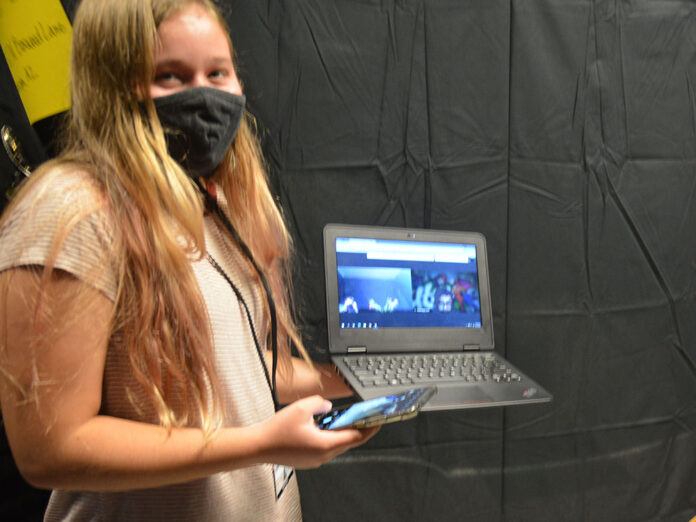
A little blood, some broken glass, strands of hair and, of course, a “dead body” are all important parts of crime scenes at Desert Wind Middle School.
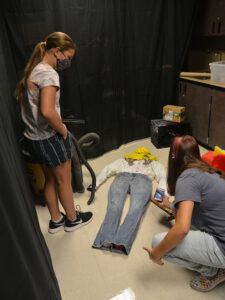 The Blended Learning classes are on the case, with students photographing, measuring, analyzing and looking for any clue. It’s a fun and educational part of the program, but this year it has been different. The classes are adapting to the COVID-19 situation that has caused nearly half of the participating students to be at home.
The Blended Learning classes are on the case, with students photographing, measuring, analyzing and looking for any clue. It’s a fun and educational part of the program, but this year it has been different. The classes are adapting to the COVID-19 situation that has caused nearly half of the participating students to be at home.
They are not being taught separately or on a different educational path. They are being taught concurrently with their on-campus colleagues.
“It’s definitely different,” said eighth grader Catherine Correa. “They’re not right here, so we can’t see the same things, so we really have to verbalize.”
It is a common challenge for secondary schools, as teachers of hands-on courses teach in-person and online simultaneously.
“It is a crazy atmosphere of computers, monitors, doc cameras and projectors with kids at home on Google Meets, kids in person spread out all over our rooms, and us just trying to make this time as productive as possible for all of our students,” said DWMS Blended Learning teacher Shannon Hull.
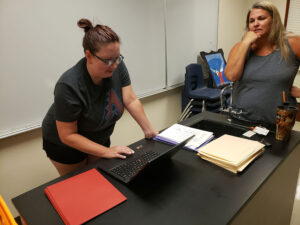
Teachers started the year exclusively online and then adapted their lessons to bring many – but not nearly all – students back to campus. If they are the only teacher in their specialty, there is added pressure to include those students who have been kept home.
Maricopa High School started the year completely with distance learning, then switched to concurrent teaching just before fall break. Not long after returning, possible exposure to people with COVID-19 had so many teachers in quarantine, the campus had to close and return to distance learning until mid-November.
Brad Chamberlain teaches networking and computer repair in Maricopa High School Career & Technical Education.
“This is a lab class,” he said. “We need to get our hands on equipment to really teach it effectively. So, I really feel for those still at home.”
During concurrent learning, about 40% of his students were continuing to distance-learn. As concurrent instruction, that only works if Chamberlain can stay on camera or manipulate the camera to follow what is being done. When he needs to wander the classroom to give individual help to in-person students, the online students can feel disenfranchised.
He said it’s not the nightmare scenario he has heard from other classes where teachers were educating up to 50 students concurrently, with nearly half at home, and trying to give them all equal time.
“One of the tough things for me is a lot of my curriculum updated this year, so I had to rewrite quite a bit of what I’ve been doing,” he said. “So, I’ve been doing that on the fly. I also teach four different preps, meaning I have four distinctly different programs.”
Chamberlain’s students came up with a couple of solutions to keep online kids engaged. One was to take advantage of old computers donated to the CTE class by Arizona Students Recycling Used Technology (AZStRUT), a partner in the department’s student-run computer-repair business, 24PinTech.
They prepped and tagged those computers and left them at the front desk for those at-home students to pick up so they could work on them at home. About 30 students participated in that way, photographing their progress removing and reinstalling the motherboard.
“Some of them did a really good job following the step-by-step instructions. Other ones weren’t quite sure,” Chamberlain said. “They’re scared they’re going to break something. I said, ‘Look these are donated computers. I don’t care, as long as it’s in the process of attempting a repair. Now, if you threw it off the roof in anger, that’s a different story.”
Some out-of-the-ordinary courses adapt to the online-to-in-person shift better than others.
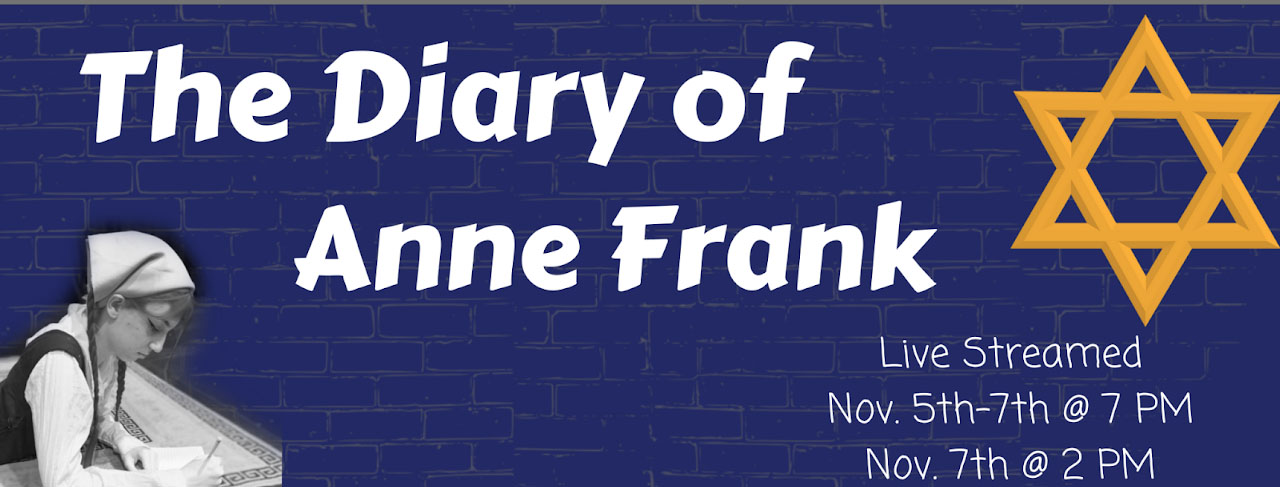
Theater teacher Alexandra Stahl has watched amateur and professional performers adapting to virtual performances, and her MHS students have done likewise.
“It is an adjustment for sure, but it is something that is allowing theaters to continue to participate in their art,” she said. “From a teaching perspective, distance learning has provided my students the ability to really hone and practice their skills.”
The students are not just learning and repeating for a grade. MHS Theatre Company, in lieu of its annual fall play, is preparing its first-ever virtual performance of “The Diary of Anne Frank” in November. It will be done via Google Meets, and the audience can purchase tickets to an online viewing platform.
“We are getting the opportunity to really evaluate a character and understand their goals and wants because in a virtual environment that is what the actor must rely on,” Stahl said. “Within the classroom, students have resiliently adapted to this new learning environment and all the new tools and tricks I and other teachers are bringing forth.”
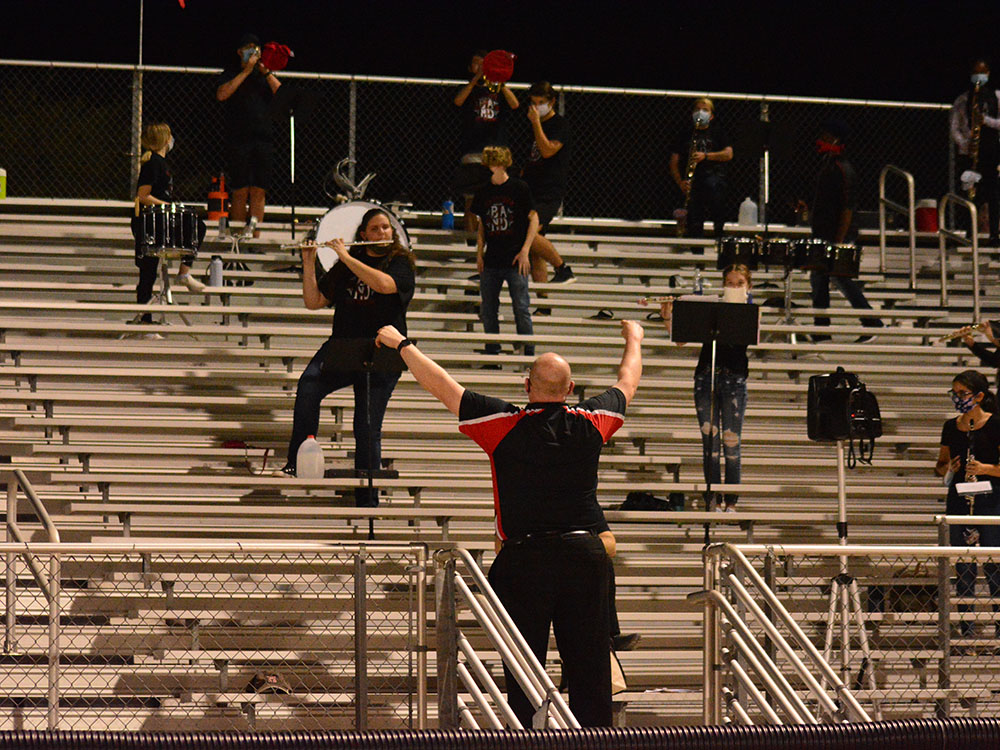
Over in the band room, director Ivan Pour split the band and orchestra classes into small, working groups for the semester. The class theme is “Our Universe,” based on space travel, plants, moons and stars. Students are working on a composing piece by Jodie Blackshaw called “13 Moons.”
“For this piece, the students get the ‘pieces’ of a band composition (like melody, counter-melody, accompaniment, A and B sections, and rhythms) and each group gets to collaborate on the format of their performance and create their own version of the piece,” Pour said.
For concerts, they are looking at combining individual performances digitally and livestreams.
“A big challenge is the one-way nature of video conferencing. That and internet lag make it impossible to play together in real time, but we can still play along with a single person while muted,” Pour said. “We can take turns ‘leading’ the group, and we can play one at a time.”
They continue to work on fundamentals with SmartMusic software, which allows them to record tracks and play along.
“The students are doing a great job overall and I’m excited we will have some amazing, creative and different performance products to share with the community this semester,” Pour said.
Chamberlain, too, has found software programs to help keep all his students involved.
“I found a program called PC Building Simulator. It’s a pretty darn good program where you actually go through the process,” he said. “You have your own workshop and can actually put these computers together. You have to select components, make sure they’re compatible. You gotta do all the cabling. It’s surprisingly detailed. I was pretty impressed with this. I had a smaller group of students take advantage of that. In these times, you have to be creative.”
Still, there is often a disconnect between online and in-person. Chamberlain spent fall break working out a fair grading system that wouldn’t burn his online students.
“There’s no magic bullet for how to do this,” he said, adding the challenge of concurrent teaching has had its benefits. “It’s made me a better teacher. Adapt or die.”
Back at Desert Wind, the Blended Learning teachers have tried to group kids for Crime Scene. Most groups have a leader, two detectives on site, a district attorney at home and a forensic expert at home. Unlike the good old days, all the students in the group will not see everything together. But the on-campus detectives bring their online counterparts to the scene by carrying around their laptops.
“There are just a lot more logistics about how … to involve everybody at home,” said Hull, who noted the new approach may be more realistic. “In real life, why would the district attorney be at the crime scene? You’re going to talk to the district attorney, but not in the same room.”
Along with Hull, teachers Joe and Jen Szoltysik and Jacque Witte concocted the criminal scenarios, made them both silly and interesting without being too gory and set up a classroom during fall break.
Hull said students are not necessarily graded on coming up with the “right” answer but in collecting evidence that supports their theory of the crime. Even staff members, hungry to be involved from home, play witnesses and suspects. On-campus students have the school resource officer helping.
After one crime scene investigation, seventh grader Asten McAnelly is analyzing fingerprints, looking for a match. This is his second year in Blended Learning but his only year in Crime Scene. His group has one “concurrent” student working the scene from home.
“It’s fine,” he said. “As long as we can get things uploaded to our folder, she can read everything and know what we’re learning and talking about.”
_________________________________________
This story appears in the November issue of InMaricopa magazine.





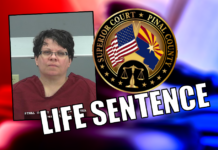
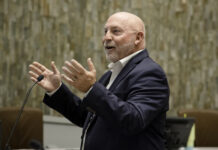
![MHS G.O.A.T. a ‘rookie sleeper’ in NFL draft Arizona Wildcats wide receiver Jacob Cowing speaks to the press after a practice Aug. 11, 2023. [Bryan Mordt]](https://www.inmaricopa.com/wp-content/uploads/2024/04/cowing-overlay-3-218x150.png)




![Alleged car thief released without charges Phoenix police stop a stolen vehicle on April 20, 2024. [Facebook]](https://www.inmaricopa.com/wp-content/uploads/2024/04/IMG_5040-218x150.jpg)




